
The Leghorn, Italian: Livorno or Livornese, is a breed of chicken originating in Tuscany, in central Italy. Birds were first exported to North America in 1828 from the Tuscan port city of Livorno, on the western coast of Italy. They were initially called "Italians", but by 1865 the breed was known as "Leghorn", the traditional anglicisation of "Livorno". The breed was introduced to Britain from the United States in 1870. White Leghorns are commonly used as layer chickens in many countries of the world. Other Leghorn varieties are less common.

The Orpington is a British breed of chicken. It was bred in the late nineteenth century by William Cook of Orpington, at that time in Kent in south-east England. It was intended to be a dual-purpose breed, to be reared both for eggs and for meat, but soon became exclusively a show bird.

The Dorking is a British breed of domestic chicken. It is named after the town of Dorking, in Surrey in southern England.

The Indian Game is a British breed of game chicken, now reared either for meat or show. It originated in the early nineteenth century in the counties of Cornwall and Devon in south-west England. It is a heavy, muscular bird with an unusually broad breast; the eggs are brown.

The Sussex is a British breed of dual-purpose chicken, reared both for its meat and for its eggs. Eight colours are recognised for both standard-sized and bantam fowl. A breed association, the Sussex Breed Club, was organised in 1903.

The Scots Dumpy is a traditional Scottish breed of chicken. It is characterised by very short legs, so short that the body is a few centimetres from the ground; as in other breeds of creeper chicken, this chondrodystrophy is caused by a recessive lethal allele. The Dumpy has at times been known by other names, among them Bakie, Corlaigh, Crawler, Creeper and Stumpy. There are both standard-sized and bantam Scots Dumpies. It is one of two Scottish breeds of chicken, the other being the Scots Grey.
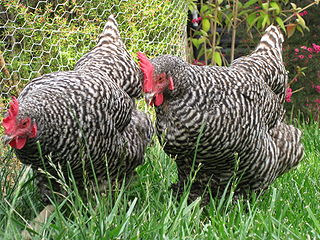
The Plymouth Rock is an American breed of domestic chicken. It was first seen in Massachusetts in the nineteenth century and for much of the early twentieth century was the most widely kept chicken breed in the United States. It is a dual-purpose bird, raised both for its meat and for its brown eggs. It is resistant to cold, easy to manage, and a good sitter.

The Japanese Bantam or Chabo is a Japanese breed of ornamental chicken. It is a true bantam breed, meaning that it has no large fowl counterpart. It characterised by very short legs and a large upright tail that reaches much higher than the head of the bird.
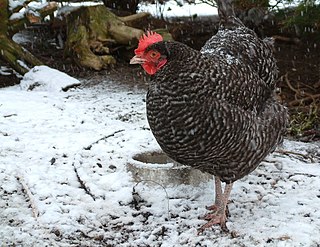
The Marans, French: Poule de Marans, is a French breed of dual-purpose chicken, reared both for meat and for its dark brown eggs. It originated in or near the port town of Marans, in the département of Charente-Maritime, in the Nouvelle-Aquitaine region of south-western France.

The Old English Game is a British breed of domestic chicken. It was probably originally bred for cockfighting. Two different standards are recognised by the Poultry Club of Great Britain: Carlisle Old English Game and Oxford Old English Game. There is also an Old English Game bantam.

The Campbell is a British breed of domestic duck. It was developed at Uley, in Gloucestershire, England, at the turn of the 20th century; being introduced to the public in 1898 and the Khaki variety in 1901.
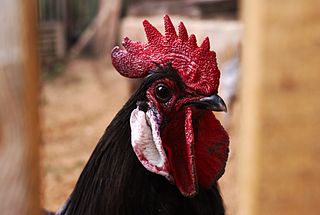
The Blue Andalusian, Spanish: Andaluza Azul, is a breed of domestic chicken indigenous to the autonomous community of Andalusia in south-west Spain. It is distributed through much of the countryside of Córdoba and Seville, and is concentrated particularly in the area of Utrera, which is considered the heartland of the breed. In 2009 the population was estimated at 10000 birds.
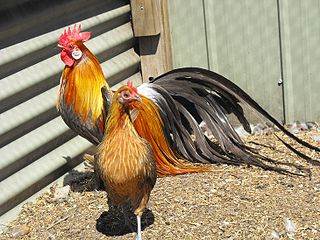
The Phoenix is a German breed of long-tailed chicken. It derives from cross-breeding of imported long-tailed Japanese birds similar to the Onagadori with other breeds.

The Legbar is a rare British auto-sexing breed of chicken. It was created in the early twentieth century by Reginald Crundall Punnett and Michael Pease at the Genetical Institute of Cambridge University. They cross-bred American barred Plymouth Rock birds with brown Leghorns and created the gold and silver colour varieties. Pease created a cream Legbar by cross-breeding these with white Leghorns; later crossing with Araucanas caused this to have a crest and to lay blue or blue-green eggs.

The Sebright is a British breed of bantam chicken. It is a true bantam – a miniature bird with no corresponding large version – and is one of the oldest recorded British bantam breeds. It is named after Sir John Saunders Sebright, who created it as an ornamental breed by selective breeding in the early nineteenth century.

A poultry show is a specific subset of a livestock show that involves the exhibition and competition of exhibition poultry, which may include chickens, domestic ducks, domestic geese, domestic guineafowl and domestic turkey. Domestic pigeon are also exhibited but not universally considered poultry. As well as being independent events, they are also sometimes held in conjunction with agricultural shows.

The Modern Game is a British breed of ornamental chicken which originated in England between 1850 and 1900. It was bred from gamecock stock, but solely as an exhibition bird.
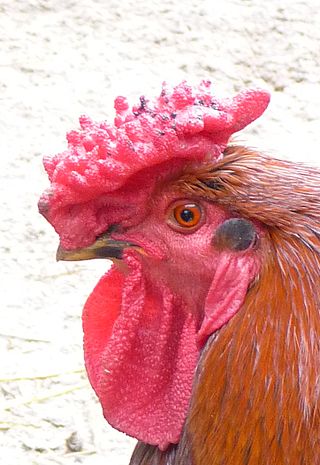
The Derbyshire Redcap is a breed of chicken originating in the English county of Derbyshire. The name "Redcap" derives from the breed's unusually large Rose-type comb. British breed standards dictate a length of more than 7 centimetres (3 inches) of length for a Redcap comb. It is covered in small, fleshy points, and has a distinct spike pointing backwards called a "leader". Combs, wattles and earlobes are all ideally bright red.

The Old English Pheasant Fowl is a British breed of small utility chicken. It derives from traditional breeds of rural Lancashire and Yorkshire and of the former counties of Cumberland and Westmorland. Its name is due to a perceived similarity of the plumage to that of the wild pheasant. It is a rare breed, and in 2014 was listed as "at risk" by the Rare Breeds Survival Trust.



















